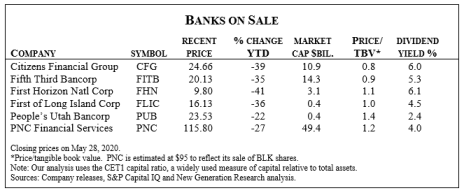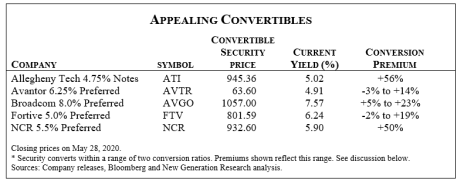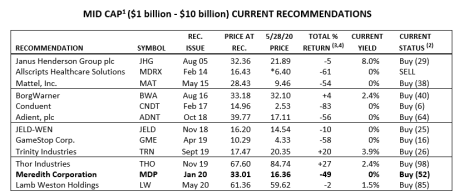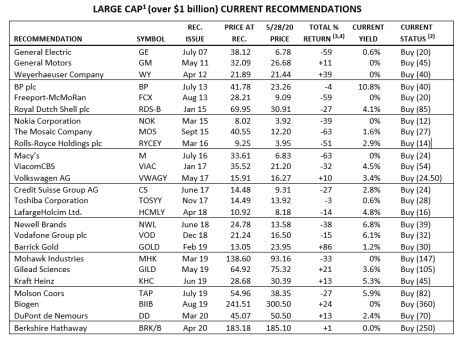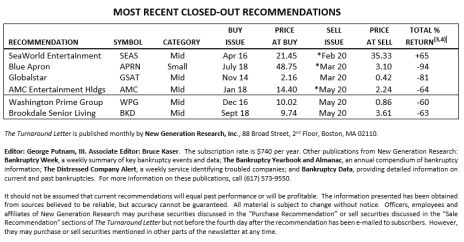Fortunately, most banks entered the current downturn in much better condition than when they entered the 2009 financial crisis. Meaningfully higher capital levels, stronger loan reserves, more stringent risk controls and tighter cost structures will all help support banks’ financial health in the difficult period ahead.
In this issue, we recommend six banks whose weak share prices imply an overly dour economic outlook.
Cabot Turnaround Letter 620
BANK STOCKS: ON SALE
In this Issue:
Bank Stocks
Appealing Convertible Securities
Recommendations:
Buy: Wells Fargo (WFC)
Price Targets Changes and Sells
Performance
With the sharp slowdown in the economy, bank stocks have declined significantly, and, unlike the broad S&P 500 Index, have not recovered much of their lost value. Year-to-date, our universe of 180 bank stocks has declined 31%, compared to the 6% decline in the broad market.
Driving the weak shares are concerns over higher credit losses, particularly in commercial real estate and small/medium business loans. Banks have begun to increase their reserves, but the extent of further losses is not fully known. A new accounting rule (Current Expected Credit Losses, or CECL) may improve visibility into future losses but requires banks to take larger upfront reserve charges, weighing on near-term earnings.
Also, interest rates have declined sharply, with 10-year Treasuries now yielding only a modest 0.70%, likely pressuring future lending margins. Smaller banks may see additional cost pressure from a need to invest in better technology as consumers visit bank branches less frequently. We would not be surprised to see some small/mid-sized banks sell to their larger peers.
Fortunately, most banks entered the current downturn in much better condition than when they entered the 2009 financial crisis. Meaningfully higher capital levels, stronger loan reserves, more stringent risk controls and tighter cost structures will all help support banks’ financial health in the difficult period ahead. Banks participating in Payroll Protection Program (PPP) lending will also benefit from incremental fee income.
Listed below are six banks whose weak share prices imply an overly dour economic outlook. We would also include in this group previously recommended Bank of America and Citigroup which we sold at much higher prices (we sold BAC at 30.89 in July 2019 and C at 81.00 in January 2020). Also, see this month’s Purchase Recommendation, Wells Fargo & Company (WFC). Most have generous dividend yields that will compensate shareholders until the sector comes back into favor.
Citizens Financial Group (CFG) – Followings its 1988 acquisition by the Royal Bank of Scotland, Citizens grew rapidly through 25 acquisitions. However, the global financial crisis led RBS to divest Citizens in 2015, with an initial public offering at $21.50. Since then, Rhode Island-based Citizens has re-focused and built a solid $176 billion in assets regional banking franchise with a deposit and lending base that is diversified across industries and geographies. Investors worry about Citizen’s below-average 9.4% capital ratio and its rising spending as it expands its capabilities. However, its low P/TBV and 8.7x earnings multiple, and reasonably well-covered 6% dividend yield, make it appealing.
Fifth Third Bancorp (FITB) – Cincinnati-based Fifth Third operates over 1,100 branches in the Midwest and Southeast. The bank is reasonably well-managed, but surprised investors with its $5 billion purchase in 2019 of Chicago-based MB Financial. Also, its loan portfolio carries some risk from its exposure to shared national credits, particularly in the energy and leisure industries. However, the MB acquisition is going well, and Fifth Third has buttressed its 9.4% capital level with a sizeable 2.1% credit loss reserve. And, its large core deposit base and effective hedging and other balance sheet management efforts appear to position the bank relatively well for lower interest rates. Its low valuation, including the 7x post-recovery earnings multiple, and its well-covered dividend, offer good value.
First Horizon National Corp (FHN) – Based in Memphis, Tennessee, First Horizon shares offer investors a higher-risk yet higher-return opportunity. The “risk” is derived from not only credit and lending margin pressures, but also from the pending purchase of 30 branches from the former SunTrust Banks and a soon-to-be-completed all-stock merger-of-equals with Louisiana-based IberiaBank. While these deals could create a more powerful and cost-efficient franchise in the Southeast with a minimal cash outlay, large bank combinations generally don’t go as smoothly as planned. Adding to the risks is First Horizon’s capital level which is reasonable at 8.5% but lower than many of its peers. The “return” is driven by modest post-merger valuations of 1.1x tangible book value and 7.6x post-recovery earnings, along with the well-covered 6.1% dividend yield.
First of Long Island Corp (FLIC) – This small-cap bank has a sturdy franchise of 52 branches throughout Long Island (New York). Conservatively managed with strong capital and below-average operating costs, the bank’s asset quality is exceptionally high, as its non-accruing loans were only 0.04% of total loans through late last year. Key to its success is its strict credit approach and focus on single-family mortgages. Its earnings cover the dividend by a factor of two. Insiders own nearly 6% of the stock, which trades at 10.7x estimated 2021 earnings.
People’s Utah Bancorp (PUB) – This well-run bank continues to show impressive results. Based just south of Salt Lake City, People’s Utah Bancorp completed its initial public offering in 2015 at $14.50. Insiders continue to own 13%. The bank has solid capital (at 12.7%) and loss reserves (2.5% of loans), and produced a healthy 14% return on equity last year. Its local markets historically have strong growth driven partly by technology companies, and its loan exposures are tilted toward the housing market which we believe will remain robust. The bank’s excess capital contributes to its slightly elevated P/TBV multiple, but earnings should continue to grow as it deploys its oversized cash position (at 30% of assets). With its shares down 27% year-to-date, and yielding 2.4%, the shares appear ready to weather the worst likely storm and thrive when the clouds clear.
PNC Financial Services (PNC) – PNC is the 6th largest bank in the country by market capitalization. Based in Pittsburgh, the bank’s core physical branches are in the Midwest, Texas and the Southeast, while it also offers digital banking services across the country. Earlier this month, PNC sold its 22% stake in Blackrock (BLK), the investment management giant, yielding over $10 billion in net proceeds. While the sale will leave an $800 million hole in PNC’s earnings (resulting in an artificially elevated P/E ratio), we believe the bank will use its new-found cash to acquire another bank, perhaps at a discounted price as it did in 2011 when it acquired RBC’s U.S. banking operations for $3.5 billion. If no worthy deal is found, the bank may repurchase its shares. The stock offers an appealing and well-covered 4.0% yield.
Disclosure note: An employee of the Publisher owns Fifth Third Bancorp (FITB) shares.
CONVERTIBLE SECURITIES: APPEALING IN THIS UNCERTAIN MARKET
The market has changed a lot since our last look at convertible bonds about six months ago. Not only has the stock market been shaken by the potential fall-out from the Covid-19 stay-at-home orders, but also interest rates have fallen sharply. The market has shown resilience, but risks clearly remain as the economic recovery may not happen as quickly as investors expect.
Convertible bonds and convertible preferred stocks can provide investors with possible participation in future gains in the underlying common stock, along with attractive yields, while providing some measure of downside protection. Because each security is convertible into a specified number of common shares, if the common stock goes up, the convertible security will trade up as well. Downside protection comes from the securities’ cash coupons and seniority in the capital structure. Unless the issuer defaults, the holder of the convertible will be paid at least the security’s face value at maturity even if the stock has not risen.
For example, ABC Industries’ $1,000 par value bond with a 5% coupon may trade at $900, reflecting only its worth as a bond. If it is convertible into 50 shares of common stock, and those shares trade at $17, the conversion value is $850 (or, 50 shares x $17). The bond is said to be trading at a 6% conversion premium (or, $900 price/$850 conversion value). But, if the share price rises to $26, then its value will increase to $1,300 (or, 50 shares x $26), and the bond will trade in-step with the underlying common stock until it is converted into stock. Moreover, it will still pay the 5% coupon until conversion. If the stock does not go up, the bond will still be worth $1,000 at maturity. The lower the conversion premium, the more the convertible’s price will follow the underlying share price.
Convertible preferred shares have similar features, except that they are junior to the company’s debt securities and do not always have a guaranteed face value, which can limit their defensive value. Nevertheless, they often pay attractive dividends, which are contractually fixed (unlike common stock dividends) and usually must be paid in full before common shareholders get any dividends. They might also be seen as a way to participate in the common stock while earning a higher dividend in the interim. Mandatory convertible preferred shares require holders to convert to common stock, allowing them to be treated as equity, rather than debt, by rating agencies. This type of preferred shares generally offers a range of conversion ratios which provides more variability around their underlying conversion value.
A few caveats: even convertible bonds are often junior to other debt of the issuer, and so in a bankruptcy, convertible securities holders may not receive much recovery (although they would still come ahead of common stockholders). Also, most convertible bonds are callable by the company, which means the company can force you to convert the bond to equity, but the company is only likely to do that if the stock has risen significantly.
Listed below are five interesting convertible securities with relatively high yields.
Allegheny Technologies 4.75% Convertible Senior Notes due July 2022 – Allegheny is a producer of specialty metals including titanium and stainless steel. With over 70% of its revenues coming from the commercial jet market, Allegheny’s prospects have weakened along with aircraft demand. However, it is likely to generate free cash flow this year, has a manageable amount of debt and will eventually participate in the industry’s recovery. The convertible notes mature at par in two years, offering 20% upside, even if the stock doesn’t rise, as well as an attractive yield. If the stock rallies to about $14.50, the bond will begin trading as a stock, providing further upside potential.
Avantor 6.25% Series A Mandatory Convertible Preferred Stock – This company has a valuable niche as a provider of materials, consumables and related equipment and services to biopharma, healthcare and advanced materials companies. In May 2019, Avantor completed a $2.9 billion initial public offering at $14. The preferred shares offer an appealing 5% yield (compared to no yield for its common shares). Holders will have their preferred shares automatically convert the $50 in liquidation preference (or, face value) into either 3.04 or 3.57 common shares in May 2022. With Avantor’s steady growth prospects, these preferred shares offer investors an opportunity to participate in the common stock’s upside while enjoying a generous yield.
Broadcom 8.0% Series A Mandatory Convertible Preferred Stock – Broadcom designs and produces semiconductors, network infrastructure and software. It purchased the corporate security operations of Symantec for $10.7 billion in 2019. The convertible’s high yield is appealing when compared to the 4.6% yield on the common stocks. Holders will need to convert the $1,000 in face value by September 2022, with the conversion ratio ranging between 3.03 and 3.54 shares.
Fortive 5.0% Series A Mandatory Convertible Preferred Stock – Fortive was spun-off from Danaher Corporation in 2016. The company acquires attractive businesses in a diverse range of industries, using a successful capital allocation strategy and the “Danaher Business System” that focuses on quality, cost and other key performance metrics. Due to Covid-19, Fortive has delayed two planned spin-offs. The preferred shares convert in July 2021 into between 10.90 and 13.33 shares of common stock. With the company’s attractive long-term future, these convertibles offer a good yield plus participation upon conversion.
NCR 5.5% Series A Convertible Preferred Stock – NCR’s primary business, producing bank ATM machines and providing related services, may be temporarily weakened but should eventually recover. NCR’s convertible preferred shares offer an interesting way to participate, partly by paying a superior dividend yield to the common (which pays no dividend). Holders may convert the securities into 33.3 common shares at their option, with no time limit, providing plenty of time to wait. Supporting the value, and the high 50% conversion premium, is the right that holders have to redeem the convertibles at the $1,000 face value after March 2024.
RECOMMENDATION
Purchase Recommendation Wells Fargo & Co (WFC)
Background:
Wells Fargo & Company is the fourth-largest bank in the country, with $2.0 trillion in assets. Founded in 1852 in San Francisco by Henry Wells and William Fargo, the bank initially offered banking services and express delivery of gold during the Gold Rush. Its survival in the Panic of 1855 and the 1906 San Francisco earthquake burnished its reputation for strength and stability. Starting in the 1980’s, Wells Fargo’s growth accelerated through acquisitions, including Crocker National Bank in 1986, First Interstate in 1996 and Norwest in 1998. During the global financial crisis, it acquired Wachovia Bank, which expanded Wells Fargo into a nationwide bank and added an investment banking business.
The bank has had its share of problems over the past decade, rooted in its weak leadership since the departure of highly-regarded CEO Richard Kovacevich in 2007, who had joined the bank with its Norwest acquisition. Since then, the company’s acquisition of troubled Wachovia and a loose compliance culture that included a fake accounts scandal has tarnished its reputation, produced a wave of litigation and led to onerous new regulations. The consent order that caps its asset size limits Wells’ ability to serve its existing customers and attract new customers – a significant competitive weakness. Further pressuring the bank’s outlook are low interest rates that will weaken its lending profits, as well as the Covid-19 recession that will likely bring significantly higher credit losses, with the eventual size of losses unknowable at this point. These issues have driven WFC shares down 60% from their peak in 2018 to decade-long lows.
Analysis:
Wells Fargo remains a valuable and diversified business, with extensive retail and commercial banking, wealth management, credit card, mortgage and investment banking franchises. Following unsuccessful turnaround efforts by two internally-sourced CEOs, the new outsider CEO appears to be returning the bank to the right track. Charles Scharf, who joined as CEO in October 2019, brings an impressive background: strong leadership success at Visa, followed by two years heading a turnaround at Bank of New York Mellon, using a skill set he developed under the tutelage of JPMorgan’s Jamie Dimon. His no-nonsense and highly capable approach has already yielded efficiency improvements, with operating expenses declining 6% from a year ago, and a new organizational structure that should improve accountability and results. We expect that over the next two years the heightened regulatory scrutiny will be lifted, removing a significant investor and strategic overhang. Future litigation losses appear to be nearly offset by reserves. We anticipate that the new leadership will improve the efficiency and effectiveness of the bank’s operations, with Wells Fargo eventually restoring its Kovacevich-era reputation.
Credit losses will undoubtedly increase over the coming quarters. Yet Wells Fargo entered the recession with a sturdy capital base (10.7% capital ratio), along with reserves that equal a sizeable 1.19% of total loans, that should help it weather the storm. WFC shares trade at low 0.8x tangible book value and a 6.9x estimated post-recovery earnings multiples. Investors will receive an attractive 7.5% dividend yield, which is reasonably likely to be sustained. After waiting years for the right time to buy WFC shares, we believe that that time is “now”.
We recommend the PURCHASE of Wells Fargo & Company (WFC) shares with a $43 price target.
SELLS AND PRICE TARGET CHANGES
We moved Allscripts Healthcare (MDRX) to a Sell mid-month as we have lost confidence in its turnaround. We also reduced our price targets on Consolidated Communications (CNSL) to 12, Janus Henderson Group (JHG) to 29, BorgWarner (BWA) to 40, Conduent (CNDT) to 6, BP (BP) to 40, Mosaic (MOS) to 27, and Mohawk Industries (MHK) to 147 based on their updated earnings and our new outlook (all retain Buy ratings). You can find more details by visiting our website at turnaroundletter.com or by email or phone request.
The following tables show the performance of all our currently active recommendations, plus recently closed out recommendations.

